Attached files
| file | filename |
|---|---|
| 8-K - Q2 EARNINGS - KBR, INC. | form8k.htm |
Exhibit 99.1

FOR IMMEDIATE RELEASE Contact: Zac Nagle
July 25, 2013 Vice President,
Investor Relations and Communications
713-753-5082
Rob Kukla, Jr.
Director, Investor Relations
713-753-5082
KBR ANNOUNCES EARNINGS PER DILUTED SHARE
OF $0.61 FOR SECOND QUARTER 2013
|
§
|
2013 EPS earnings guidance range revised to $2.55 to $2.90
|
|
§
|
Backlog book-to-bill of 1.1, excluding FX impact of $611 million
|
|
§
|
Job income up 8% and job income margins up 153 basis points, year-over-year
|
|
§
|
Continued solid balance sheet with $800 million in cash and equivalents
|
HOUSTON, Texas – KBR (NYSE:KBR) announced today that second quarter 2013 net income attributable to KBR was $90 million, or $0.61 per diluted share, compared to net income attributable to KBR of $104 million, or $0.70 per diluted share, in the second quarter of 2012.
Consolidated revenue in the second quarter of 2013 was $2.0 billion compared to $2.1 billion in the second quarter of 2012. Operating income in the second quarter of 2013 was $123 million compared to $129 million in the prior year second quarter.
“KBR delivered solid project execution in the second quarter, driving job income and job income margins up 8% and 153 basis points year-over-year, respectively,” said Bill Utt, Chairman, President, and Chief Executive Officer of KBR. “We also made strong progress on bookings in North America, with key strategic wins in Downstream with nearly $1 billion in EPC awards in ammonia and ethylene, with the technology licenses awarded related to these downstream wins, and with a North American FEED award for the Pacific Northwest LNG project in Canada in our Gas Monetization business. These wins help to affirm KBR’s position as a premiere North American contractor.”
Business Discussion (All comparisons are second quarter 2013 versus second quarter 2012, unless otherwise noted).
Hydrocarbons Results
Hydrocarbons revenue was $955 million, down $167 million, or 15%. Hydrocarbons job income was $177 million, up $13 million, or 8%.
|
·
|
Gas Monetization job income was $101 million, up $7 million, or 7%, primarily related to continued strong execution and increased volumes at two LNG projects. Partially offsetting the increase was the substantial completion of another LNG project.
|
|
·
|
Oil and Gas job income was $26 million, down $12 million, or 32%. Increased work volumes on the Shah Deniz and GDF Suez Bonaparte projects was more than offset by GVA license fees of $8 million booked in the second quarter of 2012 for several semi-submersible hulls which did not recur in the second quarter of 2013, as well as lower work volumes from the completion or near completion of several offshore projects.
|
|
·
|
Downstream job income was $22 million, up $9 million, or 69%, primarily related to increased profits from an ethylene project in Uzbekistan, a gasifier FEED in Saudi Arabia, increased work volumes at the KBR-AMCDE entity in Saudi Arabia as well as the start of the new Dyno Nobel ammonia project and a new ethylene project in the United States. Partially offsetting the increase was lower work volumes from the completion or near completion of several projects in the United States.
|
|
·
|
Technology job income was $28 million, up $9 million, or 47%, primarily related to several new ammonia projects in the United States, Bolivia, Nigeria, Indonesia, India and Hungary, as well as an ethylene project in the United States and a propylene project in China. Partially offsetting the increase was lower work volumes from the completion of ammonia projects in Brazil and China and a VCC project in Russia.
|
Infrastructure, Government and Power (IGP) Results
IGP revenue was $392 million, down $99 million, or 20%. IGP job income was $62 million, down $1 million, or 2%.
|
·
|
North American Government and Logistics (NAGL) job income was $14 million, up $9 million, or 180%. The second quarter 2012 included a net negative $18 million impact due to the adverse Tamimi Global Company, Ltd. judgment and a gain for higher cost recoveries, both related to the LogCAP III contract. Partially offsetting the increase was reduced LogCAP III project close-out recoveries and lower work volumes on the LogCAP IV contract.
|
|
·
|
International Government, Defence and Support Services (IGDSS) job income was $31 million, up $5 million, or 19%, primarily related to increased income on the Afghanistan ISP project and the new Joint Operational Fuel System contract. Partially offsetting the increase was the completion of the Temporary Deployable Accommodations project in Afghanistan.
|
|
·
|
Infrastructure job income was $8 million, down $8 million, or 50%. Higher activity on the Doha Expressway project in Qatar was more than offset by lower work volumes on water, transportation and facilities projects, primarily in Australia.
|
|
·
|
Power and Industrial (P&I) job income was $6 million, down $4 million, or 40%. Higher activity on a waste-to-energy expansion project and work performed on an emissions control EPC project was more than offset by lower work volumes from the substantial completion of engineering activities on a coal gasification project and the completion of an industrial project in Louisiana.
|
|
·
|
Minerals job income was $3 million, down $3 million, or 50%, primarily related to the completion of several minerals projects in the United States and Australia as well as decreased activity on the Hope Downs 4 iron ore project in Australia.
|
Services Results
Services revenue was $622 million, up $197 million, or 46%. Services job income was $38 million, up $9 million, or 31%, primarily related to increased activity on several module fabrication and turnaround projects in Canada as well as increased work activity in Industrial Services and Building Group.
Ventures Results
Ventures job income was $12 million, up $2 million, or 20%, primarily related to lower maintenance costs at a project in the United Kingdom.
Corporate
Corporate general and administrative expense, including $11 million related to the company’s ERP implementation, was $63 million, up $11 million, or 21%.
Second quarter of 2013 labor cost absorption expense was $17 million, which included approximately $5 million in expenses related to the closure of an office. An additional $2 million in expenses associated with the office closure was allocated to other overheads.
The effective tax rate for the second quarter 2013 was approximately 12% primarily due to favorable tax rate differentials on foreign earnings and tax reserve releases related to final negotiations of transfer pricing agreements.
Total cash used in operating activities in the second quarter of 2013 was $4 million, which included approximately $108 million paid by KBR for Pemex’s draw on performance bonds related to the EPC 1 dispute, which KBR disclosed in a Form 8-K filing in June, 2013.
During the second quarter of 2013, KBR had capital expenditures of $20 million, pension contributions of $5 million, and quarterly dividend payments of $12 million for total cash deployment of $37 million.
Updated Full Year 2013 Guidance
|
§
|
GAAP earnings per diluted share range revised to $2.55 to $2.90 (previously $2.45 to $2.90)
|
|
§
|
Corporate general and administrative expense range reduced to between $230 million and $240 million (previous range of $230 million to $250 million)
|
|
§
|
Effective tax rate range for the second half of 2013 between 24% and 26%
|
Significant Achievements and Awards
|
§
|
KBR was awarded an approximately $600 million contract by Incitec Pivot Limited’s U.S. business, Dyno Nobel, to provide engineering, procurement and construction (EPC) services, as well as technology licensing and equipment for an ammonia plant to be built in Waggaman, Louisiana. The 800,000 metric tons of ammonia per annum facility will be designed using KBR’s Purifier™ technology.
|
|
§
|
KBR was awarded an approximately $250 million EPC contract by an undisclosed client for an ammonia plant to be constructed in North America.
|
|
§
|
KBR was awarded an approximately $100 million EPC contract by an undisclosed client for two new ethylene furnaces utilizing KBR’s SCORE™ technology in North America.
|
|
§
|
KBR, partnered with JGC Corporation, was awarded a contract by Pacific NorthWest LNG Ltd., a subsidiary of Malaysia’s state-owned oil company (PETRONAS) and Japan Petroleum Exploration Co., Ltd. to execute front-end engineering and design and early detailed engineering work for a world-scale LNG export facility at Lelu Island near Prince Rupert, British Columbia. The contract calls for FEED and early detailed engineering work for a two-train LNG plant with a yearly capacity of 12 million tons and associated shipping facilities, including utilities, storage, loading, ship berthing and personnel accommodation facilities.
|
|
§
|
KBR was awarded a contract by INVISTA, a global nylon producer, to provide construction services for their next-generation manufacturing technology production facility located in Orange, Texas. Under the contract, KBR will provide pre-construction and multi-discipline construction services for mechanical, equipment settings, structural steel, electrical and instrumentation.
|
|
§
|
KBR was awarded a contract by the London Mayor’s Office for Policing and Crime to provide facilities management integrator services to the Metropolitan Police Service. The contract includes procuring, managing and auditing the facilities management supply chain on behalf of the Metropolitan Police Service. KBR will also design and manage a building management system to reduce overall maintenance costs to the metropolitan police and establish and manage a facilities management call centre.
|
|
§
|
KBR was awarded in July, 2013 a $134 million contract by the U.S. Army Corps of Engineers, Europe District to construct the facilities necessary to support Europe’s first land-based ballistic missile defense system at Romania’s Deveselu Air Base. Under this contract, KBR will re-locate a four-story radar deckhouse structure from the East Coast of the United States to Romania. In Romania, KBR will build all of the various facilities and infrastructure required to support the Aegis Ashore weapon system including roads, support buildings, communications, security and utilities.
|
KBR is a global engineering, construction and services company supporting the energy, hydrocarbons, power, industrial, civil infrastructure, minerals, government services and commercial markets. For more information, visit www.kbr.com.
NOTE: The statements in this press release that are not historical statements, including statements regarding future financial performance and backlog information, are forward-looking statements within the meaning of the federal securities laws. These statements are subject to numerous risks and uncertainties, many of which are beyond the company’s control, that could cause actual results to differ materially from the results expressed or implied by the statements. These risks and uncertainties include, but are not limited to: the outcome of and the publicity surrounding audits and investigations by domestic and foreign government agencies and legislative bodies; potential adverse proceedings by such agencies and potential adverse results and consequences from such proceedings; the scope and enforceability of the company’s indemnities from Halliburton Company; changes in capital spending by the company’s customers; the company’s ability to obtain contracts from existing and new customers and perform under those contracts; structural changes in the industries in which the company operates, escalating costs associated with and the performance of fixed-fee projects and the company’s ability to control its cost under its contracts; claims negotiations and contract disputes with the company’s customers; changes in the demand for or price of oil and/or natural gas; protection of intellectual property rights; compliance with environmental laws; changes in government regulations and regulatory requirements; compliance with laws related to income taxes; unsettled political conditions, war and the effects of terrorism; foreign operations and foreign exchange rates and controls; the development and installation of financial systems; increased competition for employees; the ability to successfully complete and integrate acquisitions; and operations of joint ventures, including joint ventures that are not controlled by the company.
KBR’s Annual Report on Form 10-K dated February 20, 2013, recent Current Reports on Forms 8-K, and other Securities and Exchange Commission filings discuss some of the important risk factors that KBR has identified that may affect the business, results of operations and financial condition. KBR undertakes no obligation to revise or update publicly any forward-looking statements for any reason.
KBR, Inc.: Condensed Consolidated Statements of Income
(Millions, except per share data) (Unaudited)
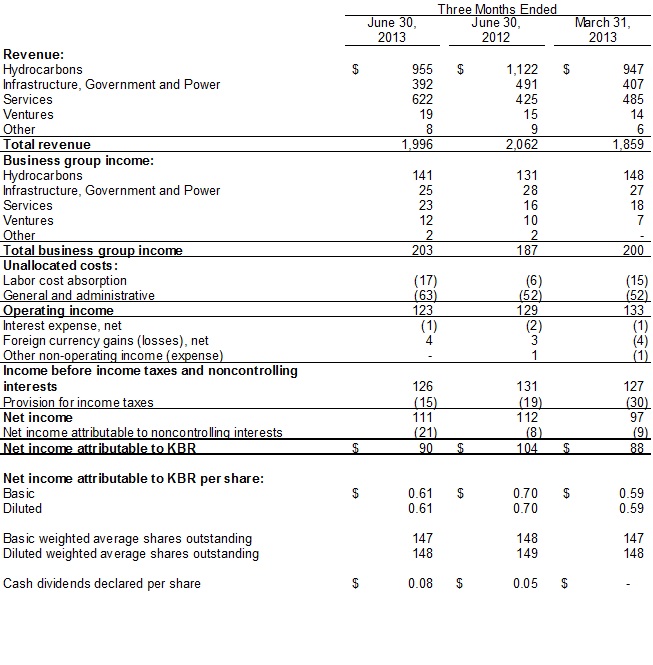
KBR, Inc.: Condensed Consolidated Statements of Income
(Millions, except per share data) (Unaudited)

KBR, Inc.: Condensed Consolidated Balance Sheets
(Millions) (Unaudited)
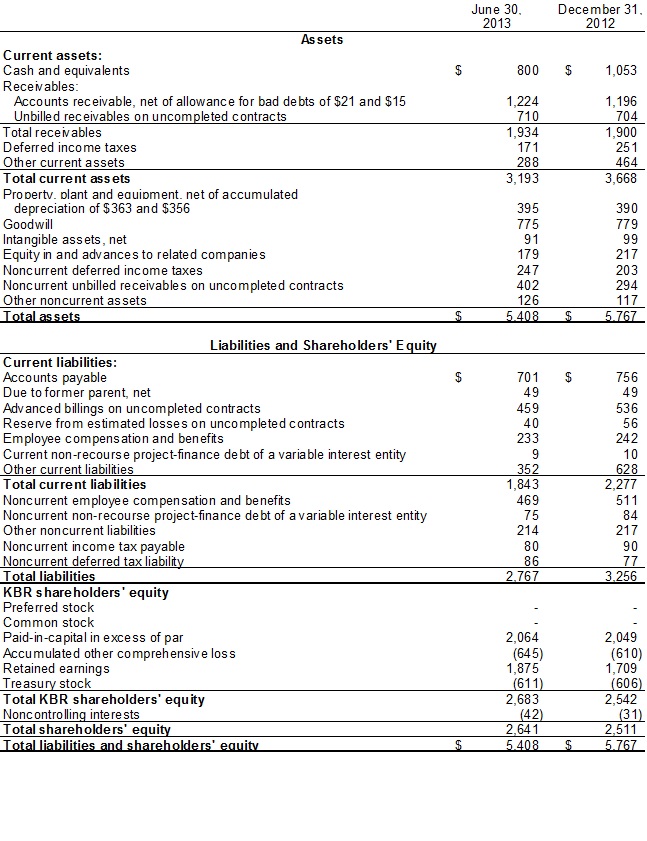
KBR, Inc.: Condensed Consolidated Statements of Cash Flows
(Millions) (Unaudited)
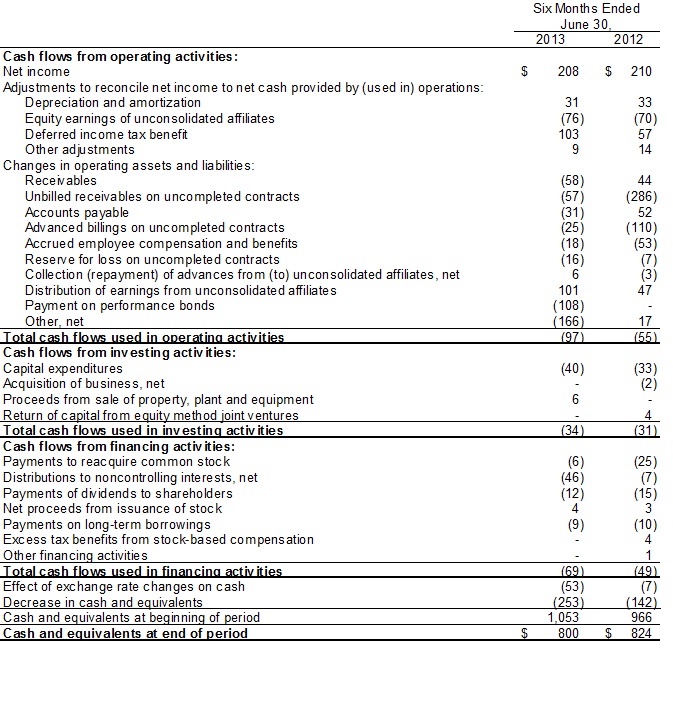
KBR, Inc.: Revenue and Operating Results by Business Unit
(Millions)(Unaudited)
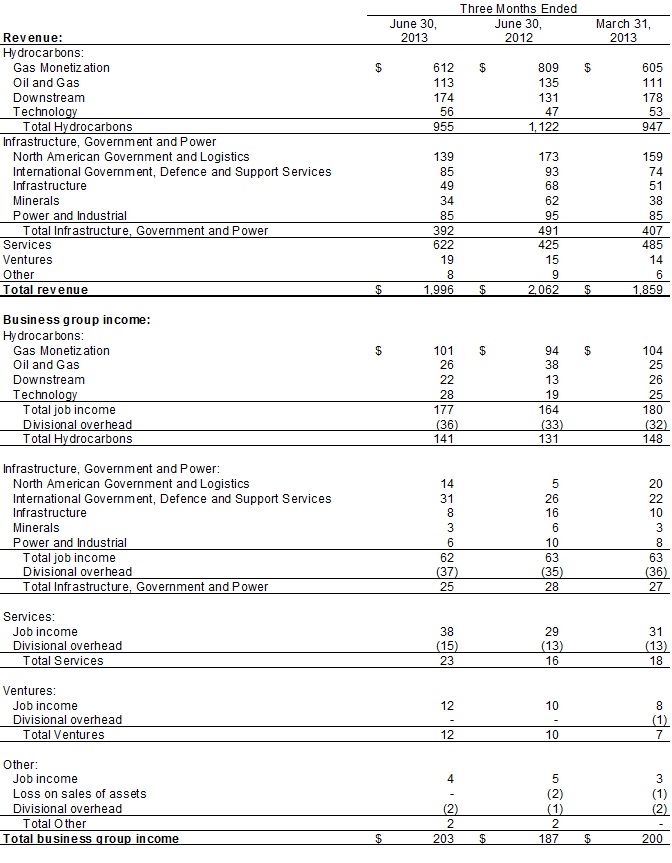
KBR, Inc.: Revenue and Operating Results by Business Unit
(Millions)(Unaudited)
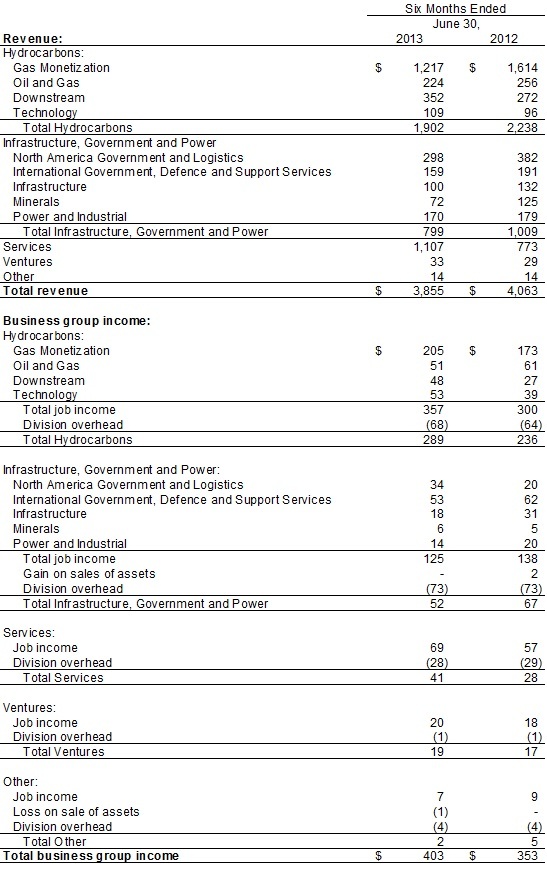
KBR, Inc.: Backlog Information (a)
(Millions) (Unaudited)
(Millions) (Unaudited)
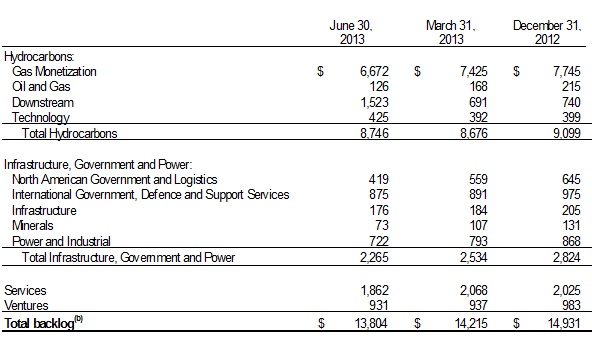
|
(a)
|
Backlog is presented differently depending on whether the contract is consolidated by KBR or is accounted for under the equity method of accounting. Backlog related to consolidated projects is presented as 100% of the expected revenue from the project. Backlog generally includes total expected revenue in backlog when a contract is awarded and/or the scope is definitized. Where contract duration is indefinite, projects included in backlog are limited to the estimated amount of expected revenue within the following twelve months. Certain contracts provide maximum dollar limits, with actual authorization to perform work under the contract being agreed upon on a periodic basis with the customer. In these arrangements, only the amounts authorized are included in backlog. For projects where KBR acts solely in a project management capacity, KBR only includes the management fee revenue of each project in backlog. For certain long-term service contracts with a defined contract term, such as those associated with privately financed projects, the amount included in backlog is limited to five years.
|
Backlog related to unconsolidated joint ventures is presented as KBR’s percentage ownership of the joint venture’s estimated revenue. However, because these projects are accounted for under the equity method, only KBR’s share of future earnings from these projects will be recorded in revenue. Our backlog for projects related to unconsolidated joint ventures totaled $5.3 billion, $5.5 billion and $5.8 billion at June 30, 2013, March 31, 2013, and December 31, 2012, respectively. Our backlog related to consolidated joint ventures with noncontrolling interest totaled $1.8 billion, $2.3 billion and $2.1 billion at June 30, 2013, March 31, 2013, and December 31, 2012, respectively.
As of June 30, 2013, 48% of our backlog was attributable to fixed-price contracts and 52% was attributable to cost-reimbursable contracts. For contracts that contain both fixed-price and cost-reimbursable components, we classify the components as either fixed-price or cost-reimbursable according to the composition of the contract except for smaller contracts where we characterize the entire contract based on the predominate component.
All backlog is attributable to firm orders as of June 30, 2013, March 31, 2013, and December 31, 2012.
|
(b)
|
Backlog attributable to unfunded government orders was $0.1 billion, $0.3 billion and $0.2 billion as of June 30, 2013, March 31, 2013, and December 31, 2012, respectively.
|
|
|
# # #
|
